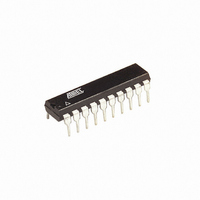ATTINY2313-20PU Atmel, ATTINY2313-20PU Datasheet - Page 128

ATTINY2313-20PU
Manufacturer Part Number
ATTINY2313-20PU
Description
IC MCU AVR 2K FLASH 20DIP
Manufacturer
Atmel
Series
AVR® ATtinyr
Datasheets
1.ATTINY2313-20MU.pdf
(226 pages)
2.ATTINY2313V-10MU.pdf
(15 pages)
3.ATTINY2313V-10SU.pdf
(20 pages)
Specifications of ATTINY2313-20PU
Core Processor
AVR
Core Size
8-Bit
Speed
20MHz
Connectivity
SPI, UART/USART
Peripherals
Brown-out Detect/Reset, POR, PWM, WDT
Number Of I /o
18
Program Memory Size
2KB (1K x 16)
Program Memory Type
FLASH
Eeprom Size
128 x 8
Ram Size
128 x 8
Voltage - Supply (vcc/vdd)
2.7 V ~ 5.5 V
Oscillator Type
Internal
Operating Temperature
-40°C ~ 85°C
Package / Case
20-DIP (0.300", 7.62mm)
Package
20PDIP
Device Core
AVR
Family Name
ATtiny
Maximum Speed
20 MHz
Operating Supply Voltage
3.3|5 V
Data Bus Width
8 Bit
Number Of Programmable I/os
18
Interface Type
SPI/USART/USI
Number Of Timers
2
Processor Series
ATTINY2x
Core
AVR8
Data Ram Size
128 B
Maximum Clock Frequency
20 MHz
Maximum Operating Temperature
+ 85 C
Mounting Style
Through Hole
3rd Party Development Tools
EWAVR, EWAVR-BL
Development Tools By Supplier
ATAVRDRAGON, ATSTK500, ATSTK600, ATAVRISP2, ATAVRONEKIT
Minimum Operating Temperature
- 40 C
Cpu Family
ATtiny
Device Core Size
8b
Frequency (max)
20MHz
Total Internal Ram Size
128Byte
# I/os (max)
18
Number Of Timers - General Purpose
2
Operating Supply Voltage (typ)
3.3/5V
Operating Supply Voltage (max)
5.5V
Operating Supply Voltage (min)
2.7V
Instruction Set Architecture
RISC
Operating Temp Range
-40C to 85C
Operating Temperature Classification
Industrial
Mounting
Through Hole
Pin Count
20
Package Type
PDIP
For Use With
ATSTK600-DIP40 - STK600 SOCKET/ADAPTER 40-PDIP770-1007 - ISP 4PORT ATMEL AVR MCU SPI/JTAGATAVRDRAGON - KIT DRAGON 32KB FLASH MEM AVRATAVRISP2 - PROGRAMMER AVR IN SYSTEMATJTAGICE2 - AVR ON-CHIP D-BUG SYSTEM
Lead Free Status / RoHS Status
Lead free / RoHS Compliant
Data Converters
-
Lead Free Status / Rohs Status
Lead free / RoHS Compliant
Available stocks
Company
Part Number
Manufacturer
Quantity
Price
Part Number:
ATTINY2313-20PU
Manufacturer:
ATMEL/爱特梅尔
Quantity:
20 000
Multi-processor
Communication
Mode
Using MPCM
128
ATtiny2313
Setting the Multi-processor Communication mode (MPCM) bit in UCSRA enables a filtering
function of incoming frames received by the USART Receiver. Frames that do not contain
address information will be ignored and not put into the receive buffer. This effectively reduces
the number of incoming frames that has to be handled by the CPU, in a system with multiple
MCUs that communicate via the same serial bus. The Transmitter is unaffected by the MPCM
setting, but has to be used differently when it is a part of a system utilizing the Multi-processor
Communication mode.
If the Receiver is set up to receive frames that contain 5 to 8 data bits, then the first stop bit indi-
cates if the frame contains data or address information. If the Receiver is set up for frames with
nine data bits, then the ninth bit (RXB8) is used for identifying address and data frames. When
the frame type bit (the first stop or the ninth bit) is one, the frame contains an address. When the
frame type bit is zero the frame is a data frame.
The Multi-processor Communication mode enables several slave MCUs to receive data from a
master MCU. This is done by first decoding an address frame to find out which MCU has been
addressed. If a particular slave MCU has been addressed, it will receive the following data
frames as normal, while the other slave MCUs will ignore the received frames until another
address frame is received.
For an MCU to act as a master MCU, it can use a 9-bit character frame format (UCSZ = 7). The
ninth bit (TXB8) must be set when an address frame (TXB8 = 1) or cleared when a data frame
(TXB = 0) is being transmitted. The slave MCUs must in this case be set to use a 9-bit character
frame format.
The following procedure should be used to exchange data in Multi-processor Communication
mode:
1. All Slave MCUs are in Multi-processor Communication mode (MPCM in UCSRA is set).
2. The Master MCU sends an address frame, and all slaves receive and read this frame. In
3. Each Slave MCU reads the UDR Register and determines if it has been selected. If so, it
4. The addressed MCU will receive all data frames until a new address frame is received.
5. When the last data frame is received by the addressed MCU, the addressed MCU sets
Using any of the 5- to 8-bit character frame formats is possible, but impractical since the
Receiver must change between using n and n+1 character frame formats. This makes full-
duplex operation difficult since the Transmitter and Receiver uses the same character size set-
ting. If 5- to 8-bit character frames are used, the Transmitter must be set to use two stop bit
(USBS = 1) since the first stop bit is used for indicating the frame type.
Do not use Read-Modify-Write instructions (SBI and CBI) to set or clear the MPCM bit. The
MPCM bit shares the same I/O location as the TXC flag and this might accidentally be cleared
when using SBI or CBI instructions.
the Slave MCUs, the RXC flag in UCSRA will be set as normal.
clears the MPCM bit in UCSRA, otherwise it waits for the next address byte and keeps
the MPCM setting.
The other Slave MCUs, which still have the MPCM bit set, will ignore the data frames.
the MPCM bit and waits for a new address frame from master. The process then repeats
from 2.
2543L–AVR–08/10















